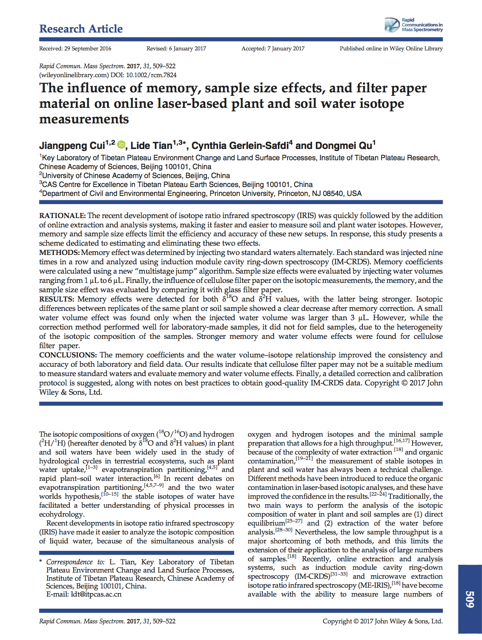The influence of memory, sample size effects, and filter paper material on online laser-based plant and soil water isotope measurements

Gerlein-Safdi, C., et al. (2017) “The influence of memory, sample size effects, and filter paper material on online laser-based plant and soil water isotope measurements”, Rapid Communications in Mass Spectroscopy, doi:10.1002/rcm.7824.
RATIONALE The recent development of isotope ratio infrared spectroscopy (IRIS) was quickly followed by the addition of online extraction and analysis systems, making it faster and easier to measure soil and plant water isotopes. However, memory and sample size effects limit the efficiency and accuracy of these new setups. In response, this study presents a scheme dedicated to estimating and eliminating these two effects.
METHODS Memory effect was determined by injecting two standard waters alternately. Each standard was injected nine times in a row and analyzed using induction module cavity ring-down spectroscopy (IM-CRDS). Memory coefficients were calculated using a new “multistage jump” algorithm. Sample size effects were evaluated by injecting water volumes ranging from 1 μL to 6 μL. Finally, the influence of cellulose filter paper on the isotopic measurements, the memory, and the sample size effect was evaluated by comparing it with glass filter paper.
RESULTS Memory effects were detected for both δ18O and δ2H values, with the latter being stronger. Isotopic differences between replicates of the same plant or soil sample showed a clear decrease after memory correction. A small water volume effect was found only when the injected water volume was larger than 3 μL. However, while the correction method performed well for laboratory-made samples, it did not for field samples, due to the heterogeneity of the isotopic composition of the samples. Stronger memory and water volume effects were found for cellulose filter paper.
CONCLUSIONS The memory coefficients and the water volume–isotope relationship improved the consistency and accuracy of both laboratory and field data. Our results indicate that cellulose filter paper may not be a suitable medium to measure standard waters and evaluate memory and water volume effects. Finally, a detailed correction and calibration protocol is suggested, along with notes on best practices to obtain good-quality IM-CRDS data.
